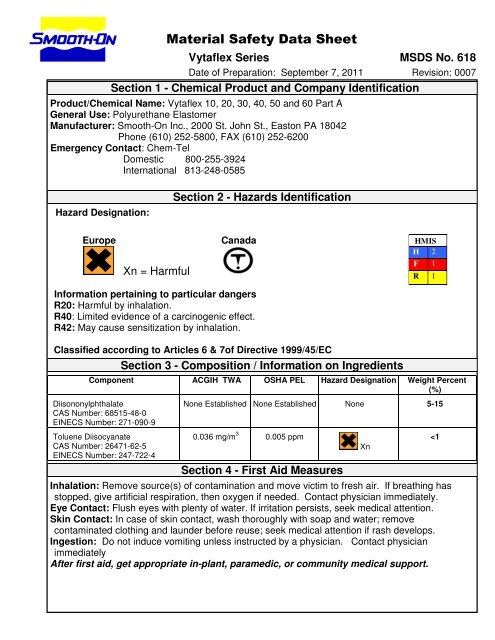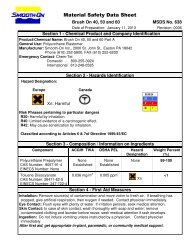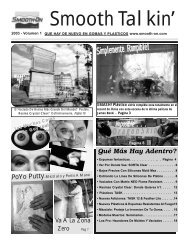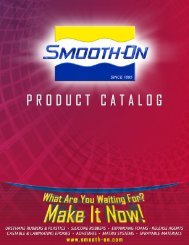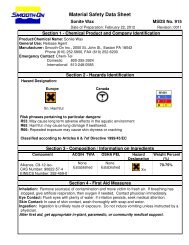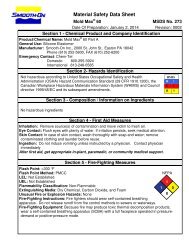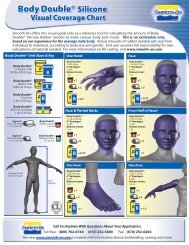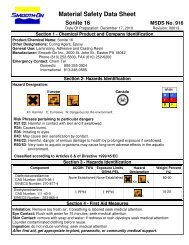MSDS - Smooth-On, Inc.
MSDS - Smooth-On, Inc.
MSDS - Smooth-On, Inc.
Create successful ePaper yourself
Turn your PDF publications into a flip-book with our unique Google optimized e-Paper software.
Material Safety Data SheetVytaflex Series <strong>MSDS</strong> No. 618Date of Preparation: September 7, 2011 Revision: 0007Section 1 - Chemical Product and Company IdentificationProduct/Chemical Name: Vytaflex 10, 20, 30, 40, 50 and 60 Part AGeneral Use: Polyurethane ElastomerManufacturer: <strong>Smooth</strong>-<strong>On</strong> <strong>Inc</strong>., 2000 St. John St., Easton PA 18042Phone (610) 252-5800, FAX (610) 252-6200Emergency Contact: Chem-TelDomestic 800-255-3924International 813-248-0585Hazard Designation:Section 2 - Hazards IdentificationEuropeXn = HarmfulCanadaHMISH 2F 1R 1Information pertaining to particular dangersR20: Harmful by inhalation.R40: Limited evidence of a carcinogenic effect.R42: May cause sensitization by inhalation.Classified according to Articles 6 & 7of Directive 1999/45/ECSection 3 - Composition / Information on IngredientsComponent ACGIH TWA OSHA PEL Hazard Designation Weight Percent(%)DiisononylphthalateCAS Number: 68515-48-0EINECS Number: 271-090-9None Established None Established None 5-15Toluene DiisocyanateCAS Number: 26471-62-5EINECS Number: 247-722-40.036 mg/m 3 0.005 ppmSection 4 - First Aid MeasuresInhalation: Remove source(s) of contamination and move victim to fresh air. If breathing hasstopped, give artificial respiration, then oxygen if needed. Contact physician immediately.Eye Contact: Flush eyes with plenty of water. If irritation persists, seek medical attention.Skin Contact: In case of skin contact, wash thoroughly with soap and water; removecontaminated clothing and launder before reuse; seek medical attention if rash develops.Ingestion: Do not induce vomiting unless instructed by a physician. Contact physicianimmediatelyAfter first aid, get appropriate in-plant, paramedic, or community medical support.Xn
<strong>MSDS</strong> No. 618 Vytaflex Series Revision: 0007Section 5 - Fire-Fighting MeasuresFlash Point: >270 °F (132°C)NFPAFlash Point Method: TOCLEL: Not Established1UEL: Not EstablishedFlammability Classification: Non-Flammable2 1Extinguishing Media: Water Fog, Dry Chemical, Carbon Dioxide Foam0Unusual Fire or Explosion Hazards: Hazardous decomposition products maybe formed. Avoid water contamination in closed containers or confined areas asexothermic heat and carbon dioxide can evolve.Fire-Fighting Instructions: Fire fighters should wear self contained breathing apparatus. Donot release runoff from fire control methods to sewers or waterways.Fire-Fighting Equipment: Because fire may produce toxic thermal decomposition products,wear a self-contained breathing apparatus (SCBA) with a full face piece operated in pressuredemandor positive-pressure mode.Section 6 - Accidental Release MeasuresSpill /Leak Procedures: <strong>On</strong>ly properly protected personnel should remain in the spill area; dikeand contain spill; absorb or scrape up excess into suitable container for disposal; wash area withdilute ammonia solution. Stop or reduce discharge if it can be done safely.Section 7 - Handling and StorageHandling Precautions: Minimize breathing of vapors and avoid prolonged or repeated contactwith skin. Wear proper protective equipment. If ventilation is not sufficient, wear properrespiratory equipment. Avoid moisture contamination. Reseal partial containers. Use goodgeneral housekeeping procedures.Storage Requirements: Store in cool dry, well-ventilated area.Section 8 - Exposure Controls / Personal ProtectionRespiratory Protection: Follow OSHA respirator regulations 29 CFR 1910.134 and EuropeanStandards EN 141, 143 and 371; wear an MSHA/NIOSH or European Standards EN 141, 143and 371 approved respirators. Warning! Air-purifying respirators do not protect workers inoxygen-deficient atmospheres. If respirators are used, OSHA requires a written respiratoryprotection program that includes at least: medical certification, training, fit-testing, periodicenvironmental monitoring, maintenance, inspection, cleaning, and convenient, sanitary storageareas.Protective Clothing/Equipment: Wear chemically protective gloves, boots, and aprons toprevent prolonged or repeated skin contact. Wear protective eyeglasses or chemical safetygoggles, per OSHA eye- and face-protection regulations 29 CFR 1910.133 and EuropeanStandard EN166. Contact lenses are not eye protective devices. Appropriate eye protectionmust be worn instead of, or in conjunction with contact lenses.Comments: Never eat, drink, or smoke in work areas. Practice good personal hygiene afterusing this material, especially before eating, drinking, smoking, using the toilet, or applyingcosmeticsPage 2
<strong>MSDS</strong> No. 618 Vytaflex Series Revision: 0007Section 9 - Physical and Chemical PropertiesPhysical State: LiquidAppearance : Clear yellow viscous liquidOdor : Sharp pungent odorVapor Pressure: None (Polymeric Resin)Vapor Density (Air=1): >1Specific Gravity (H2O=1, at 4 °C): 1.04Water Solubility: Negligible:Boiling Point: None (Polymeric Resin)% Volatile: NilFreezing/Melting Point: None (PolymericResin)Viscosity: 50 poiseSection 10 - Stability and ReactivityStability: These products are stable at room temperature in closed containers under normalstorage and handling conditions.Polymerization: Hazardous polymerization can occur.Chemical <strong>Inc</strong>ompatibilities: Strong bases, water, amines, alcohols.Conditions to Avoid: Avoid contamination with water and other materials that react withIsocyanates.Hazardous Decomposition Products: TDI vapors, hydrogen cyanide gas, oxides of nitrogen,carbon monoxide and carbon dioxideSection 11- Toxicological InformationHazardous Component LD50 Oral LC50 InhalationToluene Diisocyanate(TDI)Rat: 5800 mg/kg Rat: 140ppm/4hr.Mouse: 10ppm/4hr.None EstablishedSection 12 - Ecological InformationSection 13 - Disposal ConsiderationsDisposal: These materials must be disposed of in accordance with local regulations.Section 14 - Transport InformationDOT IATA IMDGNot Regulated Not Regulated Not RegulatedUnited States EPA Regulations:Section 15 - Regulatory InformationCERCLA Hazardous Substance (40 CFR 302.4) listed specific per RCRA, Sec. 3001; CWA,Sec. 311 (b)(4); CWA, Sec. 307(a), CAA, Sec. 112Chemical Name RQ % Reportable ComponentToluene Diisocyanate 100 lbs.
<strong>MSDS</strong> No. 618 Vytaflex Series Revision: 0007Section 15 - Regulatory Information (Continued)These products contain the following chemicals that are subject to release reporting requirementsunder section 313 of SARA Title III.Chemical Name CAS # % by WeightToluene Diisocyanate 26471-62-5
Material Safety Data SheetVytaflex Series <strong>MSDS</strong> No. 618Date of Preparation: September 7, 2011 Revision: 0007Section 1 - Chemical Product and Company IdentificationProduct/Chemical Name: Vytaflex 10, 20, 30, 40, 50 and 60 Part BGeneral Use: Polyurethane ElastomerManufacturer: <strong>Smooth</strong>-<strong>On</strong> <strong>Inc</strong>., 2000 St. John St., Easton PA 18042Phone (610) 252-5800, FAX (610) 252-6200Emergency Contact: Chem-TelDomestic 800-255-3924International 813-248-0585Hazard Designation:Section 2- Hazards IdentificationEuropeCanadaXn = Harmful N = Dangerous for the environmentHMISH 2F 1R 1Information pertaining to particular dangersR21/22: Harmful in contact with skin and if swallowed.R36: Irritating to eyes.R48/22: Harmful: danger of serious damage to health by prolonged exposure if swallowed.R50/53: Very toxic to aquatic organisms may cause long term adverse effects in the aquaticenvironment.Section 3 - Composition / Information on IngredientsComponent ACGIH TWA OSHA PEL Hazard Designation Weight Percent(%)Polyol /Plasticizer Blend None Established None Established None 90-95(Non-Hazardous)Diethyltoluenediamine None Established None Established1-5CAS Number: 68479-98-1EINECS Number: 270-877-4Xn NDi(methylthio)toluene diamineCAS Number: 106264-79-3EINECS Number: None(Vytaflex 50 & 60 <strong>On</strong>ly)None Established None Established Not Classified 5-10Section 4 - First Aid MeasuresInhalation: Remove source(s) of contamination and move victim to fresh air.Eye Contact: Flush eyes with plenty of water. If irritation persists, seek medical attention.Skin Contact: In case of skin contact, wash thoroughly with soap and water; removecontaminated clothing and launder before reuse.Ingestion: Do not induce vomiting unless instructed by a physician. Contact physicianimmediatelyAfter first aid, get appropriate in-plant, paramedic, or community medical support.
<strong>MSDS</strong> No. 618 Vytaflex Series Revision: 0007Section 5 - Fire-Fighting MeasuresFlash Point: >270 °F (132°C)NFPAFlash Point Method: PMCCFlammability Classification: Non-Flammable1Extinguishing Media: Water Fog, Dry Chemical, and Carbon Dioxide FoamUnusual Fire or Explosion Hazards: None2 0Fire-Fighting Instructions: Fire fighters should wear self-contained breathing 0apparatus. Do not release runoff from fire control methods to sewers or waterways.Fire-Fighting Equipment: Because fire may produce toxic thermal decompositionproducts, wear a self-contained breathing apparatus (SCBA) with a full face piece operated inpressure-demand or positive-pressure mode.Section 6 - Accidental Release MeasuresSpill /Leak Procedures: Dike and contain spill; absorb or scrape up excess into suitablecontainer for disposal. Stop or reduce discharge if it can be done safely.Regulatory Requirements: Follow applicable OSHA regulations (29 CFR 1910.120).Section 7 - Handling and StorageHandling Precautions: Minimize breathing of vapors and avoid prolonged or repeated contactwith skin. Wear proper protective equipment. If ventilation is not sufficient, wear properrespiratory equipment. Use good general housekeeping procedures.Storage Requirements: Store in cool dry, well-ventilated area.Section 8 - Exposure Controls / Personal ProtectionRespiratory Protection: Follow OSHA respirator regulations 29 CFR 1910.134 and EuropeanStandards EN 141, 143 and 371; wear an MSHA/NIOSH or European Standards EN 141, 143and 371 approved respirators. Warning! Air-purifying respirators do not protect workers inoxygen-deficient atmospheres. If respirators are used, OSHA requires a written respiratoryprotection program that includes at least: medical certification, training, fit-testing, periodicenvironmental monitoring, maintenance, inspection, cleaning, and convenient, sanitary storageareas.Protective Clothing/Equipment: Wear chemically protective gloves, boots, and aprons toprevent prolonged or repeated skin contact. Wear protective eyeglasses or chemical safetygoggles, per OSHA eye- and face-protection regulations 29 CFR 1910.133 and EuropeanStandard EN166. Contact lenses are not eye protective devices. Appropriate eye protectionmust be worn instead of, or in conjunction with contact lenses.Comments: Never eat, drink, or smoke in work areas. Practice good personal hygiene afterusing this material, especially before eating, drinking, smoking, using the toilet, or applyingcosmeticsPage 6
<strong>MSDS</strong> No. 618 Vytaflex Series Revision: 0007Section 9 - Physical and Chemical PropertiesPhysical State: LiquidAppearance :Off White-Light YellowOdor : Sharp pungent odorVapor Pressure: None (Polymeric Resin)Vapor Density (Air=1): >1Specific Gravity (H2O=1, at 4 °C): 1.01Water Solubility: Negligible:Boiling Point: None (Polymeric Resin)% Volatile: NilFreezing/Melting Point: None DeterminedViscosity: 3 poiseEvaporation Rate: None (Polymeric Resin)Section 10 - Stability and ReactivityStability: These products are stable at room temperature in closed containers under normalstorage and handling conditions.Polymerization: Hazardous polymerization can not occur.Chemical <strong>Inc</strong>ompatibilities: Strong acids and oxidizers.Conditions to Avoid: Avoid contamination with water and other materials that react with amines.Thermal Decomposition Products: Oxides of nitrogen, carbon monoxide and carbon dioxideNone EstablishedNone EstablishedSection 11- Toxicological InformationSection 12 - Ecological InformationSection 13 - Disposal ConsiderationsDisposal: These materials must be disposed of in accordance with applicable local regulations.Section 14 - Transport InformationDOT IATA IMDGNot Regulated Not Regulated Not RegulatedUnited States EPA Regulations:Section 15 - Regulatory InformationUS TSCA Inventory Status (40 CFR 710): All components of this product are listed on theTSCA inventory.California Proposition 65: These products do not intentionally contain any chemicals which havebeen identified by the state of California to cause cancer, birth defects or other reproductiveharm.Page 7
<strong>MSDS</strong> No. 618 Vytaflex Series Revision: 0007Canadian Regulations;Section 15 - Regulatory Information (Continued)WHMIS Identification: D2A, D2BCDSL/NDL (Canadian Domestic Substance List/Non Domestic Substance List): Listed on CDSLLabeling according to EEC DirectiveRisk Phrases Symbol(s) Required for EU Label Safety PhrasesR21/22: Harmful in contactwith skin and if swallowed.R36: Irritating to eyes.R48/22: Harmful: danger ofserious damage to health byprolonged exposure ifswallowed.R50/53: Very toxic toaquatic organisms maycause long term adverseeffects in the aquaticenvironment.Xn = HarmfulN = Dangerous for theenvironmentS2: Keep out of reach ofchildren.S26: In case of contact witheyes, rinse immediately withplenty of water and seekmedical advice.S28: After contact with skin,wash immediately with plentyof soap-suds.S36/37/39: Wear suitableprotective clothing, gloves andeye and face protection.S60: This material andcontainer must be disposedas hazardous waste.S61: Avoid release to theenvironment. (See <strong>MSDS</strong>).16 - Other InformationDisclaimer: The information contained in this <strong>MSDS</strong> is considered accurate as of the versiondate. However, no warranty is expressed or implied regarding the accuracy of the data. Sincethe use of this product is not within the control of <strong>Smooth</strong>-<strong>On</strong> <strong>Inc</strong>., it is the user's obligation todetermine the suitability of the product for its intended application and assumes all risk andliability for its safe use.This Material Safety Data Sheet is prepared to comply with the United States Occupational Safety andHealth Administration (OSHA)Hazard Communication Standard (29 CFR 1910.1200), the CanadianWorkplace Hazardous Materials Information System (WHMIS), and European Union Directive1907/2006/EEC (REACH). Hazard symbols and risk phrases are based on maximum listed concentrationof each hazardous ingredient. Unlisted ingredients are not "hazardous" per the OSHA HazardCommunication Standard (29 CFR 1910.1200), the Canadian Workplace Hazardous MaterialsInformation System (WHMIS) or the European Union (EU/EEC) directive 1907/2006/EEC and areconsidered trade secrets under US Federal Law (29CFR and 40CFR), Canadian Law (Health CanadaLegislation), and European Union Directives.Page 8


